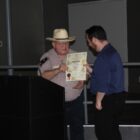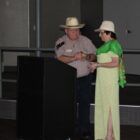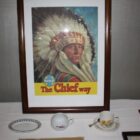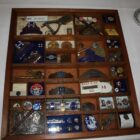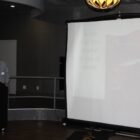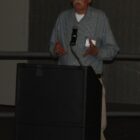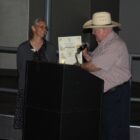Roundup: September 12 2018
Our Speaker: David R. Gunther, with almost forty years with the Santa Fe Railway and a life-time of travels around the world
His Subject: The Santa Fe Railway
Our speaker will tell us interesting things about the history of the Santa Fe Railway and from his extensive experience with the company, using materials such as passenger train literature, books of instruction, timetables, etc. to illustrate his comments. He will touch on the impact of the rail industry on the development of the American West. I have been told on good authority that David is a bona fide raconteur, so we can expect to be entertained as well as informed by his presentation.
David Gunther has a wealth of experience in management and in operations with the Santa Fe Railway, later merged with the Burlington Northern and now known as the BNSF. In operations, he served as a brakeman, conductor and certified Locomotive Engineer. In management he served, among other positions, as a highly successful educator of railway personnel, achieving extremely high passing rates for students taking qualification exams and very low injury rates for new employees who took his training. He is particularly noted for his work in safety, training and rules.
David has also traveled extensively, once circling the globe in only 46 days and taking exotic trips like driving the Karakoram Highway in Pakistan and China and traveling by rail from St. Petersburg on the Baltic Sea in Europe to Vladivostok in Siberia on the Sea of Japan.
David has also contributed significantly to industry professional organizations and to community not-for-profit organizations. For example, he was a docent at the Autry National Center for eight years and currently serves as President of the Governing Board of the Zamorano Club.
Roundup Synopsis
All aboard for the train out west! For the Westerner’s September 2018 roundup, David Gunther, a former Santa Fe Railroad locomotive engineer, shared his knowledge about railroad memorabilia. Writing in 1908 about the Santa Fe’s route, Charles Fletcher Lummis observed, “There is no railroad in the world…which penetrates such a wonderland of the pictorial in geography and humanity.”
Indeed, Mr. Gunther began the night discussing the visual art that the Santa Fe Railroad inspired. As literal engines of capitalism, railroads sought to create new markets. Railroads thereby hired artists such as Thomas Moran and Louis Akin, whose landscape paintings enticed would-be travelers to the West on the Santa Fe Railroad. For artists, perks of working on railroad advertisements included free transportation (of course), hotel accommodations, and meals. This proved a great success for the railroads. Towns were transformed with the arrival of the iron horse. Albuquerque, a place of scarcely 1,500 people, saw its population increase to 15,000 with the railroad’s arrival. Los Angeles, today a megalopolis, was only a sleepy town of a few thousand in the mid 19th century.
The recurring theme of the Santa Fe’s advertisements was the route’s singular beauty. Works like “Grand Canyon from Hermit Rim Road” by Thomas Moran displayed the untamed glory of the desert landscape, while other works captured the majesty of nature, architecture, and native peoples.
Mr. Gunther continued the night with a discussion about railroad book memorabilia. One of the standout works was Richard White’s Railroaded, which was nominated for a Pulitzer Prize in 2011. Another exciting work was By the Way, which informed travelers about the many different places outside the window along the train’s route.
Mr. Gunther convinced the audience that traveling by train was much more than just a trip from A to B. Riding the Santa Fe resembled a modern-day spa experience. A man could pay $.85 for a shave, $1.35 for a haircut, $1 for a massage, and $.35 for laundry valet services. No discussion about the Santa Fe would be complete without including Fred Harvey, who partnered with the railroad in 1876. His efforts transformed the quality of food that was served on railroad cars. He also built “Harvey House” hotels staffed by “Harvey Girls” along important Santa Fe route stops, catering to the railroad’s patrons. Today, some of the most collectable railroad memorabilia includes Santa Fe Railroad dinner menus (at one point there was a new menu for every single day) and chinaware.
In-house publications were printed by the Santa Fe Railroad for the benefit and recreation of its employees. As employee safety was of paramount importance, “Rules and Regulations” manuals were essential to run trains accident-free. For recreation, employees could turn to the Santa Fe Employee’s Magazine or The Santa Fe Magazine. Mr. Gunther rounded off the night by sharing a picture of his copy of The Little Engine That Could; the following reads on the title page: “This Book Belongs to David Gunther from Larry Jean + Ronnie Lee, Nov. 6, 1944.” The Los Angeles Corral of Westerners thanks Mr. Gunther for his informative talk on a subject so dear to him and fascinating to us.
— Dennis Bermudez


